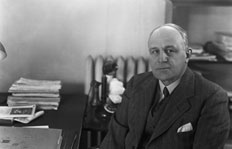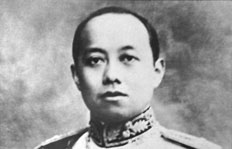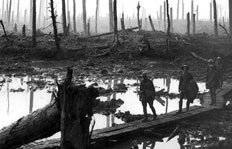Dr. Allan Coats Rankin, 1877-1959

Dr. Rankin played a leading role in the development of a degree-granting University of Alberta medical undergraduate curriculum, guiding the faculty for its first 25 years.
Earlier in his career, he took a more exotic route — researching beriberi in Thailand and working with troops in the trenches of the First World War.
After graduating from McGill in 1904, Dr. Allan Coats Rankin eventually joined the exodus of McGill medical graduates to Alberta. Dr. Rankin earned his Membership in the Royal College of Surgeons (MRCS) in 1907 and a Diploma in Public Health in 1909.
Researching beriberi in Thailand
Between 1910 and 1914, he was in Thailand as the director of the national laboratory where he was decorated by King Vajiravudh with the country’s highest honor for his research into the relationship between beriberi (a disease caused primarily by the lack of Vitamin B 1 [thiamine]) and polished rice.
Services during the First World War
Arriving in Edmonton in 1914, he replaced Dr. Revell as the second Director of the Provincial Lab.
 Just months later after the outbreak of the First World War, he joined the #1CDN General Hospital staff. During the war, he:
Just months later after the outbreak of the First World War, he joined the #1CDN General Hospital staff. During the war, he:
- Helped treat a meningococcal outbreak amongst the Canadian troops.
- Went door to door case searching and vaccinating Belgians for typhoid fever, averting another epidemic.
- Diagnosed and prevented the spread of the malaria that arrived with the Indian troops.
- Correctly diagnosed the first chlorine gas attack by the Germans. Researched the best gas masks to prepare for the future gas attacks.
- Described the widespread and debilitating trench fever in the Lancet. (Dr. Rankin’s future brother-in-law [Dr. H. Orr] would develop the Orr Hut to treat trench fever.)
Dr. Rankin was awarded a CMG by King George V before returning to the University of Alberta (U of A) to become its first Dean of Medicine in 1920.
First dean of medicine at the U of A
He oversaw the design and building of the U of A medical school (1920/21), recommended James Bertram Collip for the sabbatical that led to his groundbreaking isolation of insulin, selected the first class of 11 MDs that graduated in 1925 and the first class of dentists that graduated in 1927.
Dr. Rankin managed the Provincial Laboratory for 31 years. He was appointed to the U of A Hospital Board (UAH) when it reverted to the university in 1922 and selected its first medical staff.
In 1926, Dr. Rankin chaired the credential assessment committee for selecting and approving medical specialists in Alberta. This was the first specialist recognition system in Canada, established three years before the Royal College was formed.
He conducted TB research in cattle and proved that cattle could not transmit TB to humans.
Dr. Rankin and the faculty worked diligently to improve the U of A’s graduating class marks in the Dominion Medical Council of Canada (LMCC) exams. The class of 1935 achieved the highest average in the country, setting aside the faculty’s reputation as a second-class school.
During the Second World War, he was appointed the Lt. Col. in charge of Hygiene and Sanitary Services for the Armed Services (1939-43). He finally gained his release from the army because he was over 60 and returned to the U of A to manage the acceleration of medical classes and the design of the Mewburn Pavilion, which opened in 1945.
He received an Honorary LLD after he retired in 1945. During his 25-year deanship, 619 MDs graduated, as did many more from McGill or U of T after taking their first two years of training at the U of A.
Get the whole story!
|
 Read the full profile of Dr. Rankin in Dr. Robert Lampard's "Alberta's Medical History"
Read the full profile of Dr. Rankin in Dr. Robert Lampard's "Alberta's Medical History"